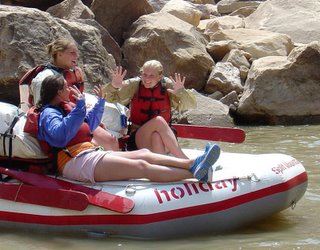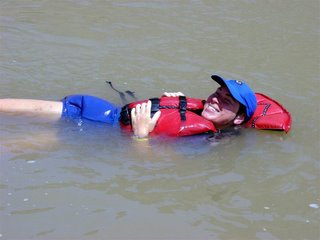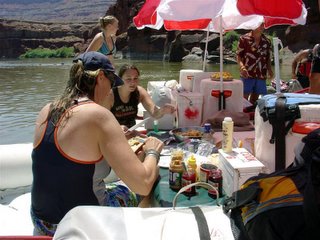One of the points of keeping a travel journal is to help you remember the little intriguing details of your journel - the kind you'd forget shortly afterward if you didn't have one. Though I've temporarily misplaced it, I was able to put together a Sunday entry before it went missing.
Sunday
We spent much of Saturday night rearranging all our stuff into white plastic kitchen garbage bags for the trip – not the most idea organizing method, but necessary because its destination was various bags to go onboard the rafts. After a good breakfast, we headed over to the Holiday Expeditions headquarters, a collection of wood buildings surrounded by sand and dry vegetation. We met our river guides sitting on the front porch of the business center: Rick, Schoon, and Cheese. We figured, correctly, Rick was the trip leader because he was the only one without a nickname.
They gave each of us a dry bag and a day bag. If you’ve never seen them before, dry bags are made out of rubberized canvas with very sturdy closures. Once you’ve put your gear in them, you fold the two sides of the opening together, and roll them down as you would a foil coffee package, pressing down on it to let all the air out. When you’re screwed down as far as you can go, you attach a nylon clip on each end to a buckle that’s attached to the bottom, and cinch each side down even further. You now have a pretty watertight bag than can be flung onto the bag and used as a seat, headrest, and (hopefully) even floatation if you need it. The only difference between the dry bag and the day bag is its size and contents; the day bag contains what you’ve guessed you’ll need for the day (sunscreen, pack towel, etc.). Our day bag contents became more and more refined as the week went on, and I kept a running list of what would be really useful the next time.
We transferred our gear into the bags, swatting at little flies all the while, and congregated around the vans that would be taking us to the drop off point.

Our rafting companions were a father and daughter couple, and a pair of adventure-loving grandparents and three of their teenage granddaughters. More on the rest of the gang later.
Our trip was billed as being down the Green River, to the confluence of it and the Colorado, then down almost to Lake Powell. Instead – and with really no notice – we drove down past Moab to a put-in on the Colorado by the "town" of Potash (nothing more than a potash plant, really) where we dropped the rafts into the water and mounted up. Underwhelming beginning, actually. Although Cheese did sort of set the tone of "we ain't in town any more" by peeing in the river in front of the ladies! And gave us an introduction to Cheese.
For those of you that don't know, the Colorado (or the Green for that matter) are not clear rivers; they're full of silt they pick up from their travels. Visibility in the Colorado at our put-in was probably six inches. By Lake Powell, where the water level had declined due to drought and therefore even more silt was dissolved, it was essentially zero. So us city slickers were at first a bit hesitant to jump into the water. However, as the guides predicted, it only took about 15 minutes of 100+ degree heat to have us looking for cooling solutions. Solution number 1 of 3: Water fight! We used buckets to sling water at each other, and it was deliciously, stunning cooling in the 10% humidity.

Shortly after that we turned to solution number 2 – jumping in. Our life vests automatically turned us on our backs, so we floated in bliss alongside the rafts.
We covered a fair amount of river mileage, most of it in the Island In The Sky district of Canyonlands and circling around Dead Horse Point, a particularly stunning viewpoint from the top of the mesas above us. These mesas were several thousand feet above us, so you could barely see the large canopy over the Point. We passed it from several angles during the day as the Colorado meandered its way along.

We quickly learned that eating was a major activity on the river. For our first lunch, the guides tied the three oar-powered (no motors) rafts together, put up portable poolside umbrellas, and whipped up a very nice shrimp salad in pita bread.
I decided to sleep under the stars, though I’m usually a tent person. I figured if I couldn’t sleep in the open here, then I’d never be able to do it anywhere. There were a dizzying number of stars overhead. The moon was so bright it felt like someone was shining a gentle spotlight on me. I could literally read by it, but it didn’t help me sleep much. Fortunately the moon set over one of the canyon walls before too long, and then the stars really came out. The Milky Way was as clear as I’d ever seen it, and finally in the wee hours the temperature dropped to probably the upper 50’s.
A word about useful items to have on a river trip. On a hot summer trip, experience showed us there are a few variations of common items you might not think of. Of course you’d want a water bottle in a place where daytime temperatures reached 115°. What you might not expect is that an insulated coffee mug (which Holiday provided with our tent package) is perfect: It’s insulated, which keeps the cool water from the drsinking jugs deliciously cool. It’s not too large, which means you won’t leave water in it to get warm, and it’s easy to manage in an existence where space is a precious commodity. It has a handle, which makes it easy to clip with a carabiner upside down (unless you want it seasoned with silty river water) to any available location. And finally, it’s really useful in the morning for actual coffee! The one drawback is that you have to be diligent to wash it out with the morning’s camp cleaning, else you’ll be tasting the not-too-subtle influence of camp coffee on your drinking water all day.
As Douglas Adams (creator of The Hitchhiker’s Guide To The Galaxy) said, “A towel is about the most massively useful…(complete)”. It certainly proved to be true on this trip. We used Outdoor Research bath sheet-sized pack towels made of microfiber (available at all your finer REIs nationwide) that pack small, absorb huge amounts of water, wring very dry, and even have a loop from which to hang it if you get the chance. I used it daily on the hotter days of the trip to cool me protect me from the most intense sun by dunking it in the water and covering up under it. The very low humidity combined with the heat made it my very own evaporative cooler, quite a bit cooler than the air around me. On the hottest night when the temperature never dropped below 95°, I wetted it down and slept underneath it. It worked so well, cooling me while protecting me from blowing sand, I woke up at about 3 when it dried to rewet it. And of course, when pressed you could actually use it as a towel.


